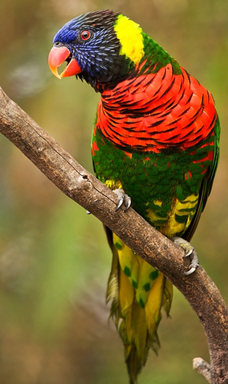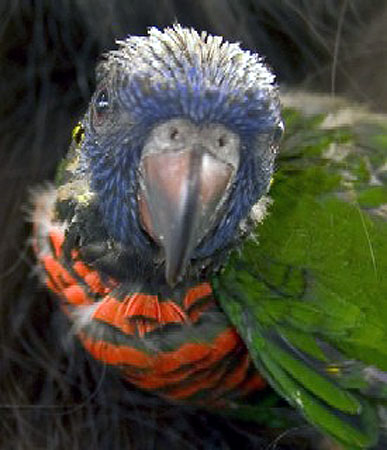Green-Naped Lorikeet
Trichoglossus haematodus haematodus
The Green-Naped Lorikeet, also called the Green Nape Lorikeet, is one of the most common of the 21 subspecies of Trichoglossus haematodus, the Rainbow Lorikeets. In the same family as parrots, their colorful plumage, acrobatic maneuvers, and wide range of vocalizations combine to make them one of the best known of the Rainbow Lorikeets.

One of our Green-naped Lorikeets. Credit: Courtesy of Robin Riggs

SPECIES IN DETAIL
Green-Naped Lorikeet
Trichoglossus haematodus haematodus
CONSERVATION STATUS: Safe for Now - Protected
CLIMATE CHANGE: Not Applicable
At the Aquarium
Our lorikeets either came from the Aquarium’s breeding program or from U.S. captive breeding programs. None have been imported. All our lorikeets including Swainson’s have distinctive personalities and even respond to the names given them by the aviculturists who feed and nurture them.
Geographic Distribution
Northern and eastern parts of Australia and the islands north and east.
Habitat
These birds have a wide range of habitats; rainforest, open forest, woodlands, mangroves, gardens, parks, orchards, and coconut plantations where they are important pollinators of coconut species. Although most common in lowlands , they are also found in mountainous regions to 4.2 m (2600 ft).
Physical Characteristics
The plumage of the Green-naped Lorikeet is an artist’s palette of rainbow colors. Its back and wings are bright green with primary wing feathers tipped in black and underwings orange-red and yellow. Its uppertail is green and its undertail grayish green with yellow. Its head is a dark bluish-violet with a lighter blue streaking on the forecrown, changing to greenish streaking on the rear crown. Its red breast feathers are edged in blue fading from blue to green in its rear chest areas. This lorikeet’s lores, the area between its eyes and bill, are blue. Mature birds have an orange-red beak and iris while those of immature birds are brown. Sub-adults also have duller plumage.
Size
This medium-sized relative of parrots can reach 26 cm(10 in) in length and a weight of 127 to 133 gm (4.5-5 oz). Males and females are similar in size although females can be shorter with a smaller bill.
Diet
Green-naped Lorikeets spend 70 percent of their time feeding primarily on nectar and pollen but also eating fruit, selected greens and seeds, insects and larvae, and unripe grains of corn and sorghum. They extract nectar with their brush-tipped tongue. After crushing the flowers with their bills, they extend the tiny, hair-like papillae (projections) at the end of their tongue to soak up the nectar and gather pollen from blossoms. They drink surface water and that trapped by leaves.
Reproduction
Becoming sexually mature when twelve to twenty-four months old, these birds are thought to mate for life. Their courtship displays include fluttering to display their underwing patterns, head bobbing, tail fanning, and fencing with their bills. They usually build their isolated nests in unlined tree hollows up to 25 m (80 ft) above the ground where two eggs are commonly laid. The male spends time in the hollow but only the female incubates the eggs. The eggs hatch after an incubation period of about 25 days. Both parents feed the chicks which leave the nest in 49 to 56 days, returning each night until they become fully independent approximately two weeks later.
Behavior
Like other subspecies of Rainbow Lorikeets, Green-naped make a number of different sounds. Fledglings have a high pitched wheeze. Pairs twitter when nesting and preening. The birds screech when flying in search or food or for other birds and chatter when feeding. If disturbed at nesting sites or when feeding on low shrubs, they protest loudly while flapping their wings.
They make daily journeys to feeding sites as far as 50 km (30 mi) away, following established flight paths to and from their roosting sites that usually parallel a coastline or a line of hills, valleys, and/or rivers. Overnight roosting flocks can number hundreds of birds while feeding flocks contain only about 20.
Hundreds of birds make up the roosts of Green Nape Lorikeets. There are several theories to explain why birds roost. Among them are sharing information about location of food resources, provide a single area where mates can be found, security in numbers, or perhaps a place for young birds to learn how to find and eat different types of food.
Adaptation
The feet of these birds have two forward and two backward facing toes. These combined with their strong bills enable them to be excellent climbers, hang up-side-down, and in general imitate Olympic gymnasts, especially when feeding.
They do not have oil glands but instead use preen using powder down. Special down feathers with tips that constantly break down form a waxy powder that the birds spread through their plumage during preening.
Longevity
25-30 years of age in the wild.
Conservation
Green-naped Lorikeets are not considered to be in danger. Export of these birds from Australia is prohibited without a special permit from the government. . .
Natural predators of these birds include Peregrine and Brown Falcons, Whistling Kites, and diamond pythons.
Special Notes
The Green-naped Lorikeet was the first lorikeet bred in captivity. This achievement led to breeding programs for other lorikeets and lories, many of which are listed as endangered or vulnerable to extinction. Captive breeding programs eliminate the need to collect these birds from the wild.
Among our Green Nape Lorikeets are some very distinct personalities. Some birds are experts at unbuttoning buttons on the shirts of guests and one can even re-button them. “Shadow” likes to play with guests, wrestling with their fingers. “Tulip” is a popular girl because she loves to hang out with the staff. “Piper” loves to vocalize and play with his food bowls. Most of our birds can talk. Their vocabularies include words such as thank you, hello, come ‘ere, watcha doin’, hi, and their names. Some even blow kisses!
SPECIES IN DETAIL | Print full entry
Green-Naped Lorikeet
Trichoglossus haematodus haematodus
CONSERVATION STATUS: Safe for Now - Protected
CLIMATE CHANGE: Not Applicable
Our lorikeets either came from the Aquarium’s breeding program or from U.S. captive breeding programs. None have been imported. All our lorikeets including Swainson’s have distinctive personalities and even respond to the names given them by the aviculturists who feed and nurture them.
Northern and eastern parts of Australia and the islands north and east.
These birds have a wide range of habitats; rainforest, open forest, woodlands, mangroves, gardens, parks, orchards, and coconut plantations where they are important pollinators of coconut species. Although most common in lowlands , they are also found in mountainous regions to 4.2 m (2600 ft).
The plumage of the Green-naped Lorikeet is an artist’s palette of rainbow colors. Its back and wings are bright green with primary wing feathers tipped in black and underwings orange-red and yellow. Its uppertail is green and its undertail grayish green with yellow. Its head is a dark bluish-violet with a lighter blue streaking on the forecrown, changing to greenish streaking on the rear crown. Its red breast feathers are edged in blue fading from blue to green in its rear chest areas. This lorikeet’s lores, the area between its eyes and bill, are blue. Mature birds have an orange-red beak and iris while those of immature birds are brown. Sub-adults also have duller plumage.
This medium-sized relative of parrots can reach 26 cm(10 in) in length and a weight of 127 to 133 gm (4.5-5 oz). Males and females are similar in size although females can be shorter with a smaller bill.
Green-naped Lorikeets spend 70 percent of their time feeding primarily on nectar and pollen but also eating fruit, selected greens and seeds, insects and larvae, and unripe grains of corn and sorghum. They extract nectar with their brush-tipped tongue. After crushing the flowers with their bills, they extend the tiny, hair-like papillae (projections) at the end of their tongue to soak up the nectar and gather pollen from blossoms. They drink surface water and that trapped by leaves.
Becoming sexually mature when twelve to twenty-four months old, these birds are thought to mate for life. Their courtship displays include fluttering to display their underwing patterns, head bobbing, tail fanning, and fencing with their bills. They usually build their isolated nests in unlined tree hollows up to 25 m (80 ft) above the ground where two eggs are commonly laid. The male spends time in the hollow but only the female incubates the eggs. The eggs hatch after an incubation period of about 25 days. Both parents feed the chicks which leave the nest in 49 to 56 days, returning each night until they become fully independent approximately two weeks later.
Like other subspecies of Rainbow Lorikeets, Green-naped make a number of different sounds. Fledglings have a high pitched wheeze. Pairs twitter when nesting and preening. The birds screech when flying in search or food or for other birds and chatter when feeding. If disturbed at nesting sites or when feeding on low shrubs, they protest loudly while flapping their wings.
They make daily journeys to feeding sites as far as 50 km (30 mi) away, following established flight paths to and from their roosting sites that usually parallel a coastline or a line of hills, valleys, and/or rivers. Overnight roosting flocks can number hundreds of birds while feeding flocks contain only about 20.
Hundreds of birds make up the roosts of Green Nape Lorikeets. There are several theories to explain why birds roost. Among them are sharing information about location of food resources, provide a single area where mates can be found, security in numbers, or perhaps a place for young birds to learn how to find and eat different types of food.
The feet of these birds have two forward and two backward facing toes. These combined with their strong bills enable them to be excellent climbers, hang up-side-down, and in general imitate Olympic gymnasts, especially when feeding.
They do not have oil glands but instead use preen using powder down. Special down feathers with tips that constantly break down form a waxy powder that the birds spread through their plumage during preening.
25-30 years of age in the wild.
Green-naped Lorikeets are not considered to be in danger. Export of these birds from Australia is prohibited without a special permit from the government. . .
Natural predators of these birds include Peregrine and Brown Falcons, Whistling Kites, and diamond pythons.
The Green-naped Lorikeet was the first lorikeet bred in captivity. This achievement led to breeding programs for other lorikeets and lories, many of which are listed as endangered or vulnerable to extinction. Captive breeding programs eliminate the need to collect these birds from the wild.
Among our Green Nape Lorikeets are some very distinct personalities. Some birds are experts at unbuttoning buttons on the shirts of guests and one can even re-button them. “Shadow” likes to play with guests, wrestling with their fingers. “Tulip” is a popular girl because she loves to hang out with the staff. “Piper” loves to vocalize and play with his food bowls. Most of our birds can talk. Their vocabularies include words such as thank you, hello, come ‘ere, watcha doin’, hi, and their names. Some even blow kisses!

